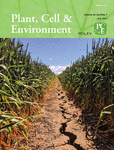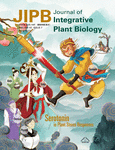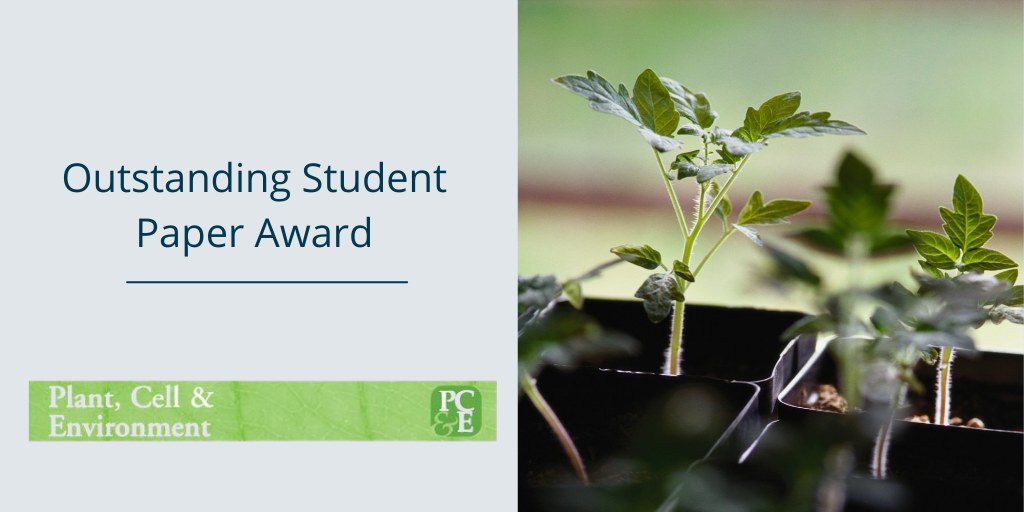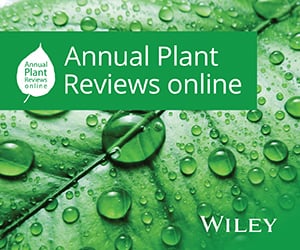Journal list menu
Export Citations
Download PDFs
COVER IMAGE
COVER IMAGE
- Page: i
- First Published: 27 June 2021
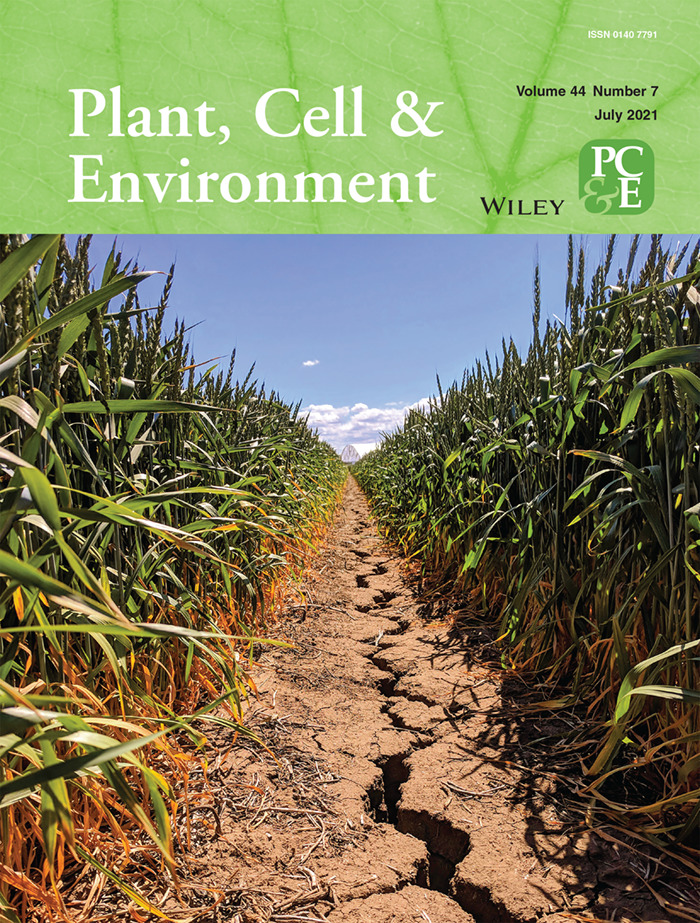
The cover image is based on the Review Responses of leaf respiration to heatwaves by Andrew P. Scafaro et al., https://doi.org/10.1111/pce.14018.
Photo credit due to Dr. Derek Collinge.
ISSUE INFORMATION
EDITORIALS
Scaling plant responses to high temperature from cell to ecosystem
- Pages: 1987-1991
- First Published: 14 May 2021
REVIEWS
Plant heat stress: Concepts directing future research
- Pages: 1992-2005
- First Published: 21 March 2021
Predicted increases in future global temperatures require us to better understand the dimensions of heat stress experienced by plants. Here we highlight four key areas for improving our approach towards understanding plant heat stress responses.
Single cell gene regulatory networks in plants: Opportunities for enhancing climate change stress resilience
- Pages: 2006-2017
- First Published: 01 February 2021
Single cell gene regulatory networks can guide research to improve crop resilience to climate change stress.
Hot topic: Thermosensing in plants
- Pages: 2018-2033
- First Published: 13 December 2020
Knowledge of how plants sense elevated temperatures and initiate protective responses has greatly increased in recent years. Diverse mechanisms, involving changes in proteins, RNA and lipids, function in thermosensing across a range of timescales, locations and temperatures.
Physiological and molecular attributes contribute to high night temperature tolerance in cereals
- Pages: 2034-2048
- First Published: 25 March 2021
Recent findings on physiological and molecular responses of rice and wheat to high night temperature (HNT) are highlighted. Special focus is directed on special adaptation strategies of HNT-tolerant cultivars (e.g., N22) and putative metabolite markers for future marker-assisted breeding to secure food supply under increasing HNT are suggested.
High night temperature effects on wheat and rice: Current status and way forward
- Pages: 2049-2065
- First Published: 12 February 2021
Impact of high night temperature on grain yield and quality in field crops, captured across spatial scales, allows the identification of tolerant germplasm, traits and mechanisms from controlled environments that have relevance under field conditions.
The potential of resilient carbon dynamics for stabilizing crop reproductive development and productivity during heat stress
- Pages: 2066-2089
- First Published: 04 February 2021
Yield limitations due to heat stress often result from perturbations to reproductive development and carbon dynamics. We review the link between these processes during heat stress and highlight source–sink dynamics, non-foliar photosynthesis and net carbon gain as key targets for climate-resilient crop development.
Responses of leaf respiration to heatwaves
- Pages: 2090-2101
- First Published: 03 February 2021
We explore the response of plant leaf respiration to heatwaves. Interconnections between assimilate use, protein activity and stability, and membrane integrity emerge as the main influences on leaf respiration, ultimately setting the upper thermal limit of respiration and plant survival.
Transpiration increases under high-temperature stress: Potential mechanisms, trade-offs and prospects for crop resilience in a warming world
- Pages: 2102-2116
- First Published: 05 December 2020
High temperature stress could lead to increased plant transpiration to enable evaporative cooling via processes that are poorly understood. Here we review potential mechanisms and discuss their implications on the need for crop water conservation dictated by increasing global evaporative demand.
ORIGINAL ARTICLE
Quantitative proteomic analysis to capture the role of heat-accumulated proteins in moss plant acquired thermotolerance
- Pages: 2117-2133
- First Published: 12 December 2020
Quantitative proteomics showed that a mild heat pre-treatment leading to acquired thermotolerance in moss strongly induces the accumulation of cytosolic HSP20s, albeit in low amounts compared to other HSPs. The cytosol was found to be the least crowded cellular compartment, suggesting that in addition to their general anti-aggregation function, cytosolic HSP20s carry specific signalling functions to regulate noxious heat-induced apoptosis.
REVIEW
Heat stress in Marchantia polymorpha: Sensing and mechanisms underlying a dynamic response
- Pages: 2134-2149
- First Published: 15 October 2020
Sensing and response to high temperatures are crucial mechanisms to prevent heat-related damage and to preserve cellular functions. In this review we aim to provide an insight into the most recent advances in elucidating the mechanisms and pathways involved in the response to heat stress in the bryophyte Marchantia polymorpha. We discuss conserved and divergent pathways that relate temperature sensing with a plethora of transduction cascades that are emerging as central future research directions.
ORIGINAL ARTICLES
Pollen development in cotton (Gossypium hirsutum) is highly sensitive to heat exposure during the tetrad stage
- Pages: 2150-2166
- First Published: 12 October 2020
Pollen function is notoriously sensitive to heat stress, imposing a risk to all food and fiber crops. Maximum temperatures of 40°C are increasingly common and yet the mechanisms by which heat damages pollen remain largely unknown.
We show that five days at 40°C during tetrad formation when meiosis is occurring led to failed dehiscence, smaller pollen grains and dramatic yield loss. Photosynthetic efficiency was not significantly compromised at 36 or even 40°C. Soluble sugar levels increased in pollen under heat stress, especially during early development, discounting carbohydrate deficits as a likely cause of impaired function.
Investigation of the proteome of pollen after transient heat stress at either the tetrad or binucleate stage showed that heat shock proteins (HSPs), particularly HSP70s, were highly up-regulated when heat was imposed after meiosis but fewer HSPs were seen after tetrads were heat-treated. This suggested a direct role for HSPs in protein folding and heat tolerance. By contrast, cytoskeletal components were highly expressed when moderate heat was imposed on tetrads, indicating a specific role in subcellular homeostasis and a potential route to the engineering of heat-stress tolerant pollen.
Transcriptome and translatome changes in germinated pollen under heat stress uncover roles of transporter genes involved in pollen tube growth
- Pages: 2167-2184
- First Published: 07 December 2020
We have used Riboprofiling to study transcription and translation of pollen germinated under normal and heat stress conditions. We found specific translational adjustments and heat down-regulation on transporter gene expression, providing molecular clues to the heat effects on plant fertilization
Contrasting anther glucose-6-phosphate dehydrogenase activities between two bean varieties suggest an important role in reproductive heat tolerance
- Pages: 2185-2199
- First Published: 30 March 2021
In this article, we describe the contribution of G6PDH in maintenance of ROS levels and by extension, its role in viable pollen production as a measure of heat tolerance in common beans. Our data indicate that continued flux of carbon through G6PDH in anthers helps remove hydrogen peroxide at high temperature in heat-tolerant bean genotype.
REVIEW
The neglected other half - role of the pistil in plant heat stress responses
- Pages: 2200-2210
- First Published: 18 April 2021
Heat stress negatively impacts pistil development, pollen-pistil interactions, fertilization and early embryo development in plants by altering the morpho-anatomical parameters, transcriptional regulation, sugar and hormonal signaling in the pistil.
ORIGINAL ARTICLES
A transcriptomic, metabolomic and cellular approach to the physiological adaptation of tomato fruit to high temperature
- Pages: 2211-2229
- First Published: 21 July 2020
Heat stress can detrimentally effect tomato (Solanum lycopersicum) fruit quality. Isoprenoids (carotenoids), volatiles and lipids are all altered by elevated heat in short bursts. Transcriptomic analyses suggest transcriptional reprogramming is the mode of action underlying these perturbations.
A shift in abscisic acid/gibberellin balance underlies retention of dormancy induced by seed development temperature
- Pages: 2230-2244
- First Published: 28 November 2020
Seed development temperature influences the level of dormancy manifested in mature seeds of wheat (Triticum aestivum L.). A shift in abscisic acid/gibberellin balance underlies the retention of dormancy level induced by seed development temperatures during post-desiccation and imbibition phases.
What happens at night? Physiological mechanisms related to maintaining grain yield under high night temperature in rice
- Pages: 2245-2261
- First Published: 13 March 2021
Physiological response to high night temperature (HNT) was explored in rice (Oryza sativa L.) heat prebreeding lines. In stems, nighttime reduction of non-structural carbohydrates, as well as starch remobilization between heading and harvest, was affected by HNT and correlated with yield.
Rethinking temperature effects on leaf growth, gene expression and metabolism: Diel variation matters
- Pages: 2262-2276
- First Published: 23 November 2020
Dynamically changing temperature affects soybean leaf growth and regulatory mechanisms in non-intuitive ways. The results may help improving knowledge transfer between experiments performed under controlled conditions and experiments performed in the field.
Root zone warming represses foliar diseases in tomato by inducing systemic immunity
- Pages: 2277-2289
- First Published: 28 January 2021
Plants are often exposed to several stresses simultaneously, particularly in agricultural settings; here, we investigate the relationships between heat and pathogen stresses. We demonstrate that root zone warming induces systemic immunity and promotes resistance to several tomato pathogens, through a process that is dependent on salicylic acid and ethylene.
The roles of photorespiration and alternative electron acceptors in the responses of photosynthesis to elevated temperatures in cowpea
- Pages: 2290-2307
- First Published: 08 February 2021
The combined effects of heat and high light (stresses that commonly co-occur in the field) on photosynthesis in cowpea (Vigna unguiculata (L.) Walp) were investigated. By comparing the photochemical and carbon assimilatory reactions, we found two striking observations. Firstly, the primary quinone acceptor (QA), a measure of the regulatory balance of the light reactions, became more oxidized with increasing temperature, suggesting increased electron sink capacity, despite the reduced CO2 fixation. Secondly, a strong, O2-dependent inactivation of assimilation capacity, consistent with down-regulation of rubisco under these conditions, a phenomenon that has not been previously reported. The dependence of these effects on CO2, O2 and light led us to conclude that both photorespiration and an alternative electron acceptor supported increased electron flow, and thus provided photoprotection, under these conditions. Some of these effects have, to our knowledge, not been previously reported, and should give important clues on the mechanisms of the high light and heat tolerance of cowpea.
Overexpression of both Rubisco and Rubisco activase rescues rice photosynthesis and biomass under heat stress
- Pages: 2308-2320
- First Published: 21 March 2021
Co-overexpression of Rubisco and Rubisco activase maintains Rubisco activation state at high temperatures, contribute to higher CO2 assimilation rate than wild type. Notably, co-overexpression line showed greater biomass production than WT at high temperatures.
Photosystem II heat tolerances characterize thermal generalists and the upper limit of carbon assimilation
- Pages: 2321-2330
- First Published: 30 December 2020
Our results suggest PSII heat tolerance is a poor proxy carbon assimilation and does not improve assimilation at higher temperatures but is likely to indicate the high-temperature constraint on photosynthesis and may characterize thermal generalists with slow carbon acquisition strategies.
Acclimation of leaf photosynthesis and respiration to warming in field-grown wheat
- Pages: 2331-2346
- First Published: 07 December 2020
In field-grown wheat, leaf-level CO2-based traits (photosynthesis, carboxylation capacity and respiration measured at 25°C) did not exhibit classic acclimation responses to warming generated by varying time of sowing; by contrast, O2-based respiration did.
Photosynthetic plasticity of a tropical tree species, Tabebuia rosea, in response to elevated temperature and [CO2]
- Pages: 2347-2364
- First Published: 23 March 2021
We report thermal acclimation and CO2 acclimation of photosynthesis of saplings of tropical tree species Tabebuia rosea grown at +4°C and 800 ppm CO2, even after brief (~2 weeks) exposure. This was underpinned by changes in biochemical parameters VCMax and JMax, not by changes in stomatal conductance.
Heat priming improved heat tolerance of photosynthesis, enhanced terpenoid and benzenoid emission and phenolics accumulation in Achillea millefolium
- Pages: 2365-2385
- First Published: 25 June 2020
Heat priming of Achillea millefolium plants improved tolerance of photosynthesis to subsequent heat shock stress and increased terpene emissions and phenolics accumulation, emphasizing the functional role of secondary metabolites in enhancing resistance to severe heat stress.
Wheat morpho-physiological traits and radiation use efficiency under interactive effects of warming and tillage management
- Pages: 2386-2401
- First Published: 01 November 2020
Understanding the interactive effects of different warming levels and tillage managements on crop morphological and physiological traits and radiation use efficiency (RUE) is essential for breeding climate-resilient cultivars, which, however, have rarely been investigated. Here, we conducted temperature free-air controlled enhancement (T-FACE) experiments on winter wheat during two growth seasons (2018/19, 2019/20) in the North China Plain. The experiments consisted of three warming treatments (CK: no warming, T1: warming 1.3°C and T2: warming 2.3°C above ambient temperature) and two tillage treatments (CT: conventional tillage and NT: no-tillage). We investigated the interactive effects of different warming levels and tillage managements on winter wheat morphological and physiological traits and radiation use efficiency. The results showed that the interactive effects of warming and tillage treatments had major impacts on wheat morphological and physiological traits, and subsequently on canopy light interception, photosynthesis, biomass and RUE. In the normal season (2018/19), warming had significant positive effects on major morphological and physiological traits and increased significantly RUE of yield (RUEY) and biomass (RUEDM) by 13.3 and 11.3%, 19.3 and 12.4%, 42.3 and 43.7%, respectively, under the treatments of CTT1, CTT2 and NTT1 relative to the control (CTN, NTN). By contrast, in the warmer season (2019/20), warming had negative effects on leaf width, light extinction coefficient, light-saturated net photosynthetic rate, aboveground, stems and spike biomass, and RUE from anthesis to maturity and consequently grain yield under conventional tillage, but positive effects under no-tillage. Our findings bring new insights into the mechanisms on the interactive effects of warming and tillage treatments on wheat growth and productivity; provide valuable information on crop ideotypic traits for breeding climate-resilient crop cultivars.
Drought and heat wave impacts on grassland carbon cycling across hierarchical levels
- Pages: 2402-2413
- First Published: 10 April 2020
• It is indispensable to explore the mechanisms and impacts of climate extremes on the carbon cycle given they are increasing in magnitude and frequency.• Aboveground biomass responses to climate extremes rely on the functional group compensatory effects and feedbacks of root system responses.• Plant physiological adjustments and shifts in community composition co-regulate ecosystem CO2 fluxes under climate extremes.
Leaf heat tolerance of 147 tropical forest species varies with elevation and leaf functional traits, but not with phylogeny
- Pages: 2414-2427
- First Published: 05 April 2021
To determine the variation in leaf heat tolerance and investigate what explains such variation, we measured heat tolerance traits for 147 plant species of tropical lowland and pre-montane forests in Panama. Variation in heat tolerance was related to elevation and leaf traits associated with leaf thermoregulation and leaf construction costs, but not to phylogenetic relatedness of the species.
Photosynthetic quantum efficiency in south-eastern Amazonian trees may be already affected by climate change
- Pages: 2428-2439
- First Published: 27 April 2020
Although high-temperature tolerance of photosystem II (PSII) in trees from the southern Amazonian forests was the highest in the literature, maximum air temperatures during the dry periods has already reached levels that overlap with the range of PSII temperature sensitivity.




